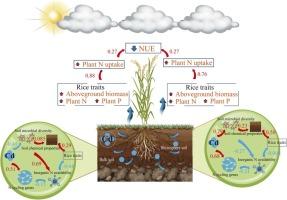Cadmium accumulation suppresses rice nitrogen use efficiency by inhibiting rhizosphere nitrification and promoting nitrate reduction
IF 11.3
1区 环境科学与生态学
Q1 ENGINEERING, ENVIRONMENTAL
引用次数: 0
Abstract
Cadmium (Cd) pollution significantly disrupts paddy soil nitrogen (N) availability and impairs rice nitrogen use efficiency (NUE). However, most existing studies rely on microcosm or pot experiments, with limited field-based manipulative studies involving Cd addition. The regulatory mechanisms by which N transformation processes influence rice N utilization under Cd stress remain poorly understood. In this study, a field experiment incorporating multiple levels of Cd addition was conducted to address this gap. Plant traits, nutrient content, and microbial community characteristics in rhizosphere and bulk soils were examined through soil chemical analysis, metagenomic sequencing, and bioinformatics approaches. The results demonstrated that microbial communities, soil N transformation potential, and rice NUE responded to Cd addition in a dose-dependent manner, with rhizosphere soils exhibiting greater sensitivity than bulk soils. Cd addition reduced dissolved organic carbon (DOC), NH₄⁺-N, and NO₃⁻-N in rhizosphere soil, while increasing total and available phosphorus (P) contents in both rhizosphere and bulk soils. Although Cd addition enhanced aboveground biomass and total N uptake, it led to a decline in plant N concentration and NUE. Moreover, Cd accumulation markedly suppressed the abundance of nitrification genes while promoting genes involved in dissimilatory nitrate reduction to ammonium (DNRA) and denitrification. Overall, Cd stress altered microbial community structure and soil N and P availability, thereby impairing rice N uptake and NUE. These findings suggest that acute Cd exposure rapidly disrupts microbial ecology, decouples the soil N cycle, and reduces N supply potential of paddy soils and rice NUE, ultimately threatening agroecosystem stability in southern China. These impacts warrant greater consideration in future farmland management strategies.

镉积累通过抑制根际硝化作用和促进硝酸盐还原来抑制水稻氮素利用效率
镉污染严重破坏水稻土壤氮素有效性,降低水稻氮素利用效率。然而,大多数现有的研究依赖于微观或盆栽实验,涉及镉添加的现场操作研究有限。镉胁迫下氮素转化过程影响水稻氮素利用的调控机制尚不清楚。在本研究中,进行了一个包含多个水平镉添加的田间试验,以解决这一差距。通过土壤化学分析、宏基因组测序和生物信息学方法,研究了根际和块状土壤的植物性状、养分含量和微生物群落特征。结果表明,微生物群落、土壤氮素转化潜力和水稻氮素利用效率对Cd添加的响应呈剂量依赖性,根际土壤比块状土壤表现出更大的敏感性。Cd的加入降低了根际土壤中溶解有机碳(DOC)、NH₄⁺-N和NO₃⁻-N,同时增加了根际土壤和块状土壤中全磷和有效磷(P)的含量。添加Cd虽然提高了地上生物量和全氮吸收量,但导致植株氮素浓度和氮素利用效率下降。Cd积累显著抑制了硝化基因的丰度,而促进了与硝酸异化还原成铵(DNRA)和反硝化有关的基因的丰度。总体而言,镉胁迫改变了微生物群落结构和土壤氮磷有效性,从而损害了水稻氮素吸收和氮肥利用效率。这些结果表明,急性镉暴露会迅速破坏微生物生态,使土壤氮循环脱钩,降低水稻土氮供应潜力和水稻氮素利用效率,最终威胁中国南方农业生态系统的稳定。这些影响值得在未来的农田管理策略中更多地考虑。
本文章由计算机程序翻译,如有差异,请以英文原文为准。
求助全文
约1分钟内获得全文
求助全文
来源期刊

Journal of Hazardous Materials
工程技术-工程:环境
CiteScore
25.40
自引率
5.90%
发文量
3059
审稿时长
58 days
期刊介绍:
The Journal of Hazardous Materials serves as a global platform for promoting cutting-edge research in the field of Environmental Science and Engineering. Our publication features a wide range of articles, including full-length research papers, review articles, and perspectives, with the aim of enhancing our understanding of the dangers and risks associated with various materials concerning public health and the environment. It is important to note that the term "environmental contaminants" refers specifically to substances that pose hazardous effects through contamination, while excluding those that do not have such impacts on the environment or human health. Moreover, we emphasize the distinction between wastes and hazardous materials in order to provide further clarity on the scope of the journal. We have a keen interest in exploring specific compounds and microbial agents that have adverse effects on the environment.
 求助内容:
求助内容: 应助结果提醒方式:
应助结果提醒方式:


